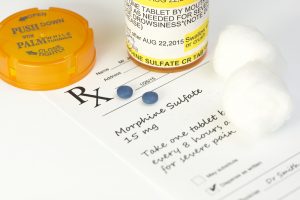Opium is well known for its pain relief effects and for its use as surgical analgesia for several centuries. A Sumerian clay tablet, dated back to 2100 B.C., is widely believed to be the world’s oldest recorded list of medical prescriptions. Those who study the tablet believe that it references the opium poppy plant.
This shows that substances like morphine were used in the earliest times of human civilization and that opium use was well-known in ancient Mesopotamia. For centuries, it has been used recreationally, but there has never been a problem like what the United States is facing today.
Opium derivatives like morphine became popular pain relievers back in the late 1800s before the consequences were really understood about opioid abuse. Heroin was also synthesized for medical use before physicians became aware of its addictive properties.
In this early time, it was impossible to know the effects these drugs could have on such a wide scale. This was all discovered on a trial and error basis.
In 1849 during the American gold rush, thousands of Chinese came to California gold fields to mine for gold. They also brought their habit of smoking opium with them. They soon established opium dens.
These were places where you could buy, sell, and smoke opium in so-called Chinatowns. By 1870 this has become a popular habit for many American’s. By 1875, San Francisco became the first city to pass legislation trying to limit opium use. This made it a misdemeanor to maintain or spend time near an opium den.
What Is Morphine?
Morphine is a prescription opioid and a natural derivative of the opium poppy plant. It is a part of the opiate family which is found to occur naturally in a number of plants and animals. It acts directly on the central nervous system (CNS) in a fashion that decreases the feeling of pain. It is prescribed for both chronic pain and acute pain.
Drugs like benzodiazepines indirectly affect the central nervous system, whereas morphine binds to and activates opioid receptors in our brain. The natural hormones that bind to our opioid receptors are called endorphins – this name is a combination of endogenous and morphine.
The purpose of endorphins is to manage the pain response in the body from a site of pain to the spine and then to the brain. The human body has opioid receptors located all over the body. These include areas like in our bones, soft tissue, and organs.
Pain signals are then sent through the nervous system to alert you to a problem. These nerve cells pass the signal rapidly through the body until endorphins are released to ease the pain and help you recover. They work by binding to the nerve cells that send and receive pain signals and block the signal from moving forward. This is most evident after exercise.
The issue with morphine is that the euphoria it provides also affects the reward center of the brain. The limbic system, which is in close relation to the reward center of your brain, is designed to pick up rewarding activities and encourage them to be repeated.
The brain can actually trick the body into believing that taking morphine is a life-sustaining action even after the pain has subsided from the body. In order to do so, it requires high doses or frequent use for morphine to affect the limbic system. It can become a severe substance use disorder that requires treatment to overcome.
What Are the Signs of Morphine Addiction?
The earliest stages of addiction are often difficult to spot. This is because the full cycle of addiction has not taken place. However, the longer substance abuse continues, it can be more difficult to hide.
Just like any disease, early detection is key to getting someone the help that could save their life. If you’re worried about either you or a loved one’s morphine consumption turning into a substance use disorder, there are telltale signs that indicate a growing addiction.
 One of the first ways to pinpoint substance use is a growing tolerance. Once your body grows comfortable with the drug in its system, you still feel that the effects gradually become weaker.
One of the first ways to pinpoint substance use is a growing tolerance. Once your body grows comfortable with the drug in its system, you still feel that the effects gradually become weaker.
The nervous system will start to counteract the drug to balance brain chemistry. This can eventually lead to physical dependence when your body begins to rely on the drug to maintain normal functions.
If you taper use or stop taking morphine altogether, you may feel uncomfortable withdrawal symptoms. Opioid withdrawal has been compared to the worst flu you will ever have with side effects, including body aches, nausea, vomiting, diarrhea, and sweating.
If you or a loved one might be struggling with a morphine addiction, there are some outward signs and symptoms to look for. Behavioral signs of opioid addiction include:
How Dangerous Is Morphine?
Morphine is not quite as dangerous when administered by medical professionals in a hospital setting. However, when the drug is abused, it can be extremely dangerous. Like all opioids, taking too high of a dose can put the user in a state of respiratory distress, causing coma and even death. For this reason, morphine should only be used as prescribed by doctors or in a hospital setting.
The withdrawal symptoms can be very uncomfortable, but not as dangerous as what you might expect from alcohol or benzodiazepine withdrawal. However, it can be deadly in some rare instances. The symptoms can lead to vomiting, diarrhea, and sweating, which could lead to dehydration. The safest way to go through the withdrawal process safely is with medical supervision.
One of the biggest dangers that pain pills pose is that they’re often expensive and hard to obtain. This causes those with active addictions to seek out their fix in another way, and this is when people see heroin as an alternative. It’s cheaper and more potent, but you never know what you can actually be getting. It could be cut with fentanyl which could cause an overdose instantly if they’re not used to its strength.
Morphine Withdrawal
Those who take smaller doses of morphine will experience withdrawal symptoms that are less severe than someone who consumes a lot. There will be similar symptoms across the board, but the severity is going to be dependent on how heavily someone uses morphine.
Morphine is an extremely potent substance, and withdrawal symptoms are often the sole reason why someone chooses not to get help. Reaching out for the help you need will allow for manageable symptoms through the process.
A morphine user will experience specific withdrawal symptoms once they’ve become tolerant to morphine, which includes:
As we described above, morphine withdrawal is not life-threatening when comparing to alcohol or benzodiazepines. Complications can occur if other drugs are used along with morphine. If benzos or alcohol are present in your system during withdrawal, the symptoms can be deadly if not treated adequately.
Morphine Overdose
Unfortunately, despite morphine being a widely used painkiller, many people abuse it for its euphoric effects. Once someone has become addicted, their tolerance will skyrocket and cause them to use higher doses to achieve their desired outcomes. When someone uses higher doses of the potent painkiller, it puts them at a higher risk of overdosing. If you or someone you love is using morphine, you must become aware of morphine overdose symptoms. It can save a life if you are prepared. These symptoms include:
In the event of a morphine overdose, you must immediately call 911. Do not induce vomiting unless told to do so by the operator. If possible, you must determine the following information:
What Is Involved in Morphine Addiction Treatment?
Morphine addiction treatment will start off in the most intensive portion of care. Medical detoxification will allow the client to address their specific needs and have a medical team to ensure their safety and comfort during this process.
Detox will last anywhere from three to seven days. If you experience any difficulties or setbacks during the process, the team will administer medication to combat withdrawals. Detox is the best choice for treating co-occurring medical issues such as other chronic diseases.
Once you’ve been stabilized, it may be best to go through medication-assisted outpatient treatment. This process will be customized to meet your unique needs and will make use of replacement medications alongside clinical therapies to help prevent relapse and strengthen your sobriety.
You will meet with therapists to address the factors that are fueling your addiction. Treatments could include family therapy, individual therapy, group therapy, and cognitive-behavioral therapy. This will allow you to begin adjusting behaviors and coping with relapse triggers.
The sole purpose of addiction treatment is to start a dialogue about the substance use disorder you’re experiencing. This will help you with emotional, physical, social, and any legal problems you could be facing that threatens your sobriety.